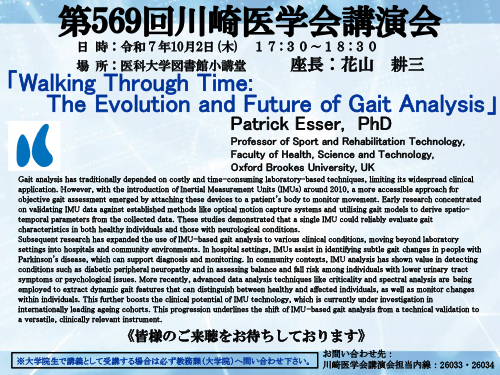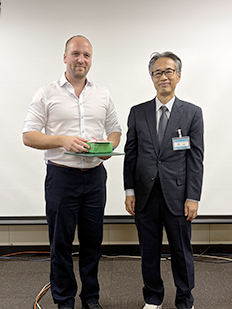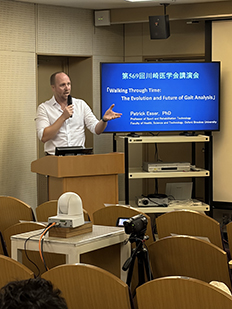Menu
過去の講演会
第569回川崎医学会講演会
| 日 時 | 令和7年10月2日(木)17:30~18:30 |
| 場 所 | 医科大学図書館小講堂 |
| 座 長 | 花山 耕三 |
| 演 題 | 「Walking Through Time: The Evolution and Future of Gait Analysis」 |
| 演 者 | Patrick Esser, PhD Professor of Sport and Rehabilitation Technology, Faculty of Health, Science and Technology, Oxford Brookes University, UK |
Gait analysis has traditionally depended on costly and time-consuming laboratory-based techniques, limiting its widespread clinical application. However, with the introduction of Inertial Measurement Units (IMUs) around 2010, a more accessible approach for objective gait assessment emerged by attaching these devices to a patient's body to monitor movement. Early research concentrated on validating IMU data against established methods like optical motion capture systems and utilising gait models to derive spatio-temporal parameters from the collected data. These studies demonstrated that a single IMU could reliably evaluate gait characteristics in both healthy individuals and those with neurological conditions.
Subsequent research has expanded the use of IMU-based gait analysis to various clinical conditions, moving beyond laboratory settings into hospitals and community environments. In hospital settings, IMUs assist in identifying subtle gait changes in people with Parkinson's disease, which can support diagnosis and monitoring. In community contexts, IMU analysis has shown value in detecting conditions such as diabetic peripheral neuropathy and in assessing balance and fall risk among individuals with lower urinary tract symptoms or psychological issues. More recently, advanced data analysis techniques like criticality and spectral analysis are being employed to extract dynamic gait features that can distinguish between healthy and affected individuals, as well as monitor changes within individuals. This further boosts the clinical potential of IMU technology, which is currently under investigation in internationally leading ageing cohorts. This progression underlines the shift of IMU-based gait analysis from a technical validation to a versatile, clinically relevant instrument.
詳細はこちら
※ 大学院生で講義として受講する場合は必ず教務課(大学院)へ問い合わせ下さい。


